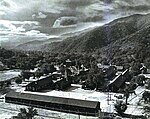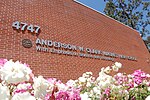Rancho Tujunga
1840 establishments in Alta CaliforniaCalifornia ranchosCrescenta ValleyHistory of Los AngelesHistory of the San Fernando Valley ... and 5 more
Lake View Terrace, Los AngelesRanchos of Los Angeles County, CaliforniaStates and territories disestablished in 1875States and territories established in 1845Sunland-Tujunga, Los Angeles
Rancho Tujunga was a 6,661-acre (26.96 km2) Mexican land grant in the western Crescenta Valley and northeastern San Fernando Valley, in present-day Los Angeles County, California. It was granted in 1840 by Mexican governor Juan Alvarado to Francisco Lopez and Pedro Lopez.The rancho lands included the present-day Los Angeles communities of Lake View Terrace, Sunland, and Tujunga.
Excerpt from the Wikipedia article Rancho Tujunga (License: CC BY-SA 3.0, Authors).Rancho Tujunga
Doane Canyon Road, Los Angeles Sunland
Geographical coordinates (GPS) Address Phone number Nearby Places Show on map
Geographical coordinates (GPS)
| Latitude | Longitude |
|---|---|
| N 34.28 ° | E -118.3 ° |
Address
LADWP Open Space
Doane Canyon Road
91040 Los Angeles, Sunland
California, United States
Open on Google Maps






